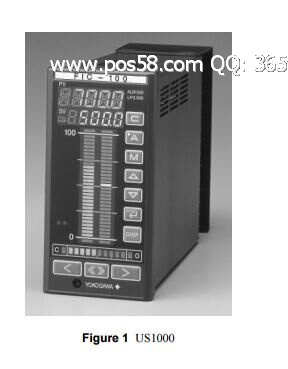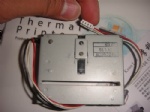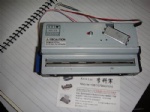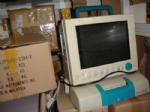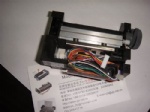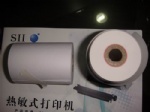 |
Shenzhen Yujinxiang Technology Co. Ltd/(Thermal / Dot mini Printer Mechanisms) |
|
|||
| Home | About Us | Products | News | Payment | FAQ | Feedback | Contact Us |
|
Products
A long time has passed since the word "downsizing" was first coined. In the field of instrumentation, total cost reduction is continually being sought, with this trend becoming even more accelerated as a result of the present economic recession. Users generally select controllers, recorders, and other instruments from among the diverse range of models available, based on its suitability to the user's application in respect to functions, performance, and price. Now however, the primary concern in model selection is by how much the total cost of instrumentation can be slashed. In response to this change in the market, we slimmed down the range of control functions and the number of inputs and outputs of the controller and developed the US1000, a new- generation general-purpose controller that offers a compact design at a low price while still delivering the same level of high reliability and performance as earlier models. The objectives posted for the new product development were:
Figure 1 shows an external wiew of the US1000. HARDWARE
In order to achieve a compact and lightweight controller, the casing was designed with the aim of reducing the depth to half and the weight to one third that of earlier single-loop controllers. To accomplish this, the number of structural parts and circuit boards was reduced to half. Structure The same parts that were used in the Green series controllers, which made their debut in 1996, are also employed in the US1000. The combination of all of these field-proven parts, namely, the terminals, panel-mounting brack- ets, built-in reference-junction compensation (RJC) sensor and terminal connectors, assures instrument reliability. As shown in Figure 2, the main components of the US1000 are a drip- proof (IP65) case with gasket, a bezel with inte- grated key tops, a panel sheet that improves visibility, two types of LED holders that widen the angle of view and two (or three for full- option models) highly integrated boards. This design realized a simple and easy-to-assemble structure. Electric Circuits Figure 3 shows the electric circuits. The main board, on which the processor, analog and digital I/O units and power supply unit are integrated, together with the display board can perform single-loop control. With the addition of an extension I/O board, dual-loop control and valve-position proportional control is also possible.
Figure 3 Circuit Block Diagram
A noise analysis tool was used during the designing, manufacturing of trial versions, and assessment of printed circuit boards in order to achieve conformance to the EMC standards (relating to noise immunities) required in the EU market. This tool scans over a printed circuit board with the detector antenna to capture noise information, such as the points from which noises are radiated, the frequency components, and the radiation levels (dB and μV), and display them visually on a computer screen. By doing this, proper countermeasures can be taken and their effect checked in a short time. Figure 4 shows an example of noise analysis data displays. The noise level is distinguished by 8 colors where areas giving off the highest level of noise are displayed in red and those giving off the least noise in violet. In the bottom window, the spectrum of noise at the point that generates the highest level of noise is displayed to show the relationship between the noise level and the frequency at that point. LED DISPLAY UNITS An 11-segment LED unit is used for easy identification of alphanumeric characters when setting parameters and the like (see Figure 5). To further enhance the visibility, data items are displayed in different colors––the measured value (PV) in orange, the setpoint (SV) in green, and the status in yellow. Figure 6 shows the detailed structure of the 11-segment LED unit. The key strengths in the structural design include:
Efficient Engineering of Structural Design A three-dimensional CAD was used for the engineering of the US1000's structural design. By using this technology and laser sculpturing to manufacture test versions of the molded parts, the time taken to prepare the required manufacturing documentation can be cut to less than half, enabling a mold to be finished off in only a short period of time. Compliance with International Standards The US1000 conforms to and/or has obtained approval for various, respective international standards, such as the CE Mark and, CSA and FM standards. Approval has already been received from the CSA and FM for the general safety standard and non- incendive (simplified flameproof) standard. This enables the US1000 to be installed in class-2 hazardous areas, which is relatively less hazardous and therefore only incurs minimal installation costs. FIRMWARE
The US1000 allows the user to select the controller mode suitable for the particular controlled process from among 13- provided modes including single-loop control, dual-loop control, and cascade control. Figure 7 shows a function block diagram for a US1000. Two independent PID computation blocks, an input computation block, and an output computation block make up the control functions of a US1000. The input and output computation blocks are user-programmable, as custom computations can be set for them. This programming can be done easily by allotting computation modules inside the input or output block and making connections between the modules and input/output terminals. A wide variety of computation modules such as logic operation, filter, moving average, and flow totalizer modules are prepared in order to enable a diverse range of applications. The choice of a controller mode from the various controller modes mentioned above should be previously coded in the input or output computation block. Users can configure a controller by adding desired functions to a provided controller mode or creating their own unique controller mode.
Figure 7 Function Block Diagram for US1000 ENGINEERING TOOLSTwo software packages are available as the engineering tools for the US1000: the LL1100 for the setting of parameters via a personal computer, and the LL1200 for the configuration of custom computations. These tools can run under Windows 95 or Windows NT 4.0, and allow the user to save parameters and custom computation configurations and printout engineering results. Both tools are equipped with a help function for referring to parts of the operation manual. Figures 8 and 9 show examples of the displays of these software applications. Using the Tuning View dialog box (Figure 8), the user can tune the PID control parameters while monitoring the process data. Figure 9 shows the Custom Computation Creation window, which allows the temperature and pressure compensation for a flow rate to be configured. A desired custom computation can be easily coded by choosing menu commands to allot the computation modules and establish the connections.
CONCLUSIONThis report outlines the features, structure, and functions of the US1000, a compact low-cost solution to current market needs. The US1000 was developed by slimming down the range of functions to include only those required for standard digital indicating controllers. We believe that the US1000 is one of the best product solutions available for achieving cost reductions at users' plants. We will continue to keep our eyes on changes in the market and shall continue to pursue functional improvements in order to meet those ever-changing needs and provide solutions for a diverse range of user requirements.
Related Products & Solutions LL1100The software package that enables you to set the configuration parameters of model US1000 Digital Indicating Controller via the optical communications adapter attached on controller front panel. Parameter data upload and download, read, write and print parameters, file management, trend display, tuning functions are available.  LL1200The software package used to create custom computation programs and custom display functions for LL1200. computation program upload and download, file management, debugging and printing functions are available. The funciton of LL1100 is also included.  US100072×144×100 mm sized Digital Indicating Controller has clear bar graph display for PV, SV and MV. It comes with powerful 14 control modes, including optional Custom Computation and dual loop control. The universal input, auto-tuning, "SUPER" functions are standard. Position proportional control and RS485 communication are optionally available. 
[Next:HR2300/ER2400 YOKOGAWA MARKING RIBBON 12 COLOUR -]→
|
|
|||||||||||||||||||||||||||||||||||
Copyright (c) 2016 Shenzhen Yujinxiang Technology Co. Ltd/(Thermal / Dot mini Printer Mechanisms) All Rights Reserved


